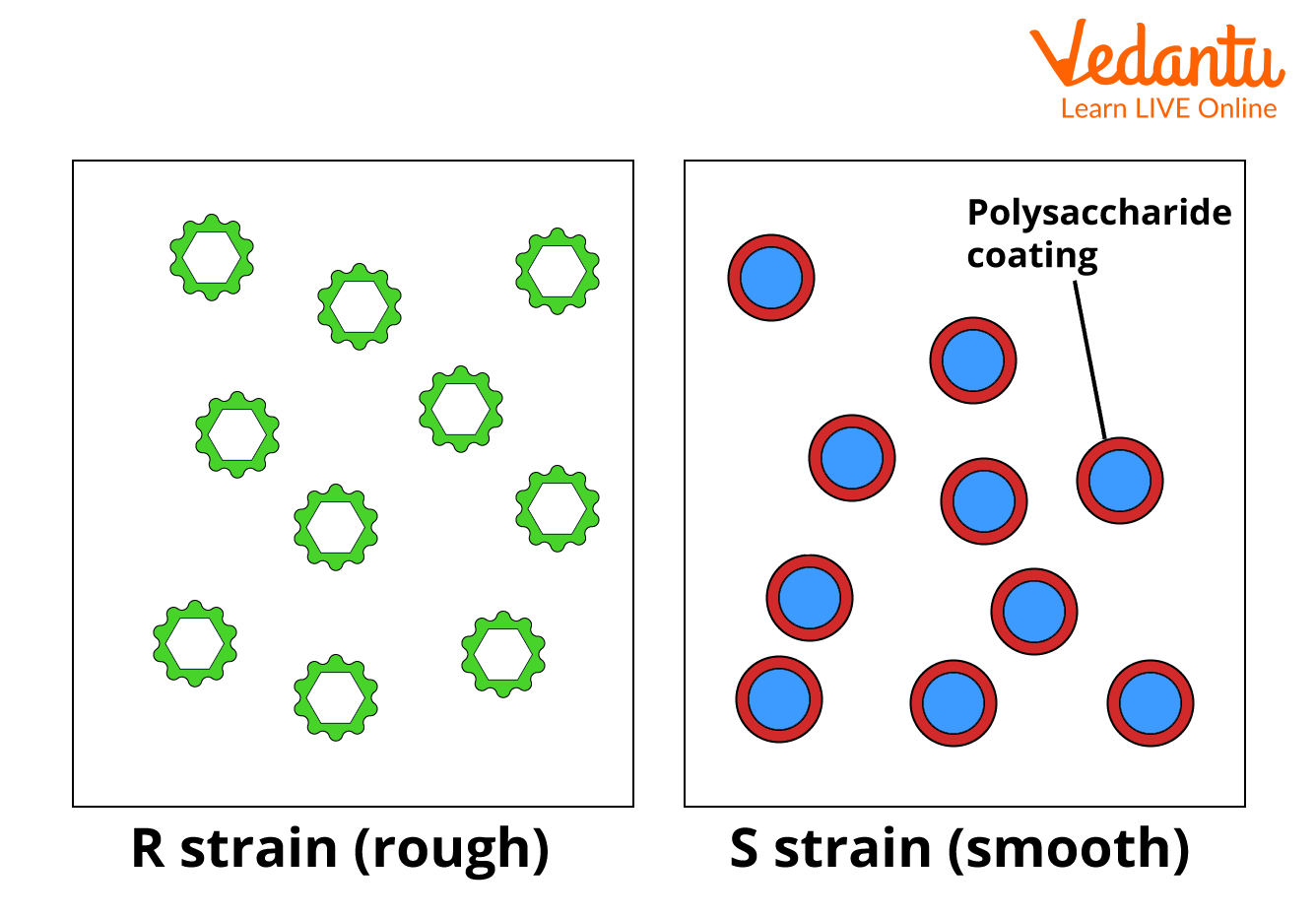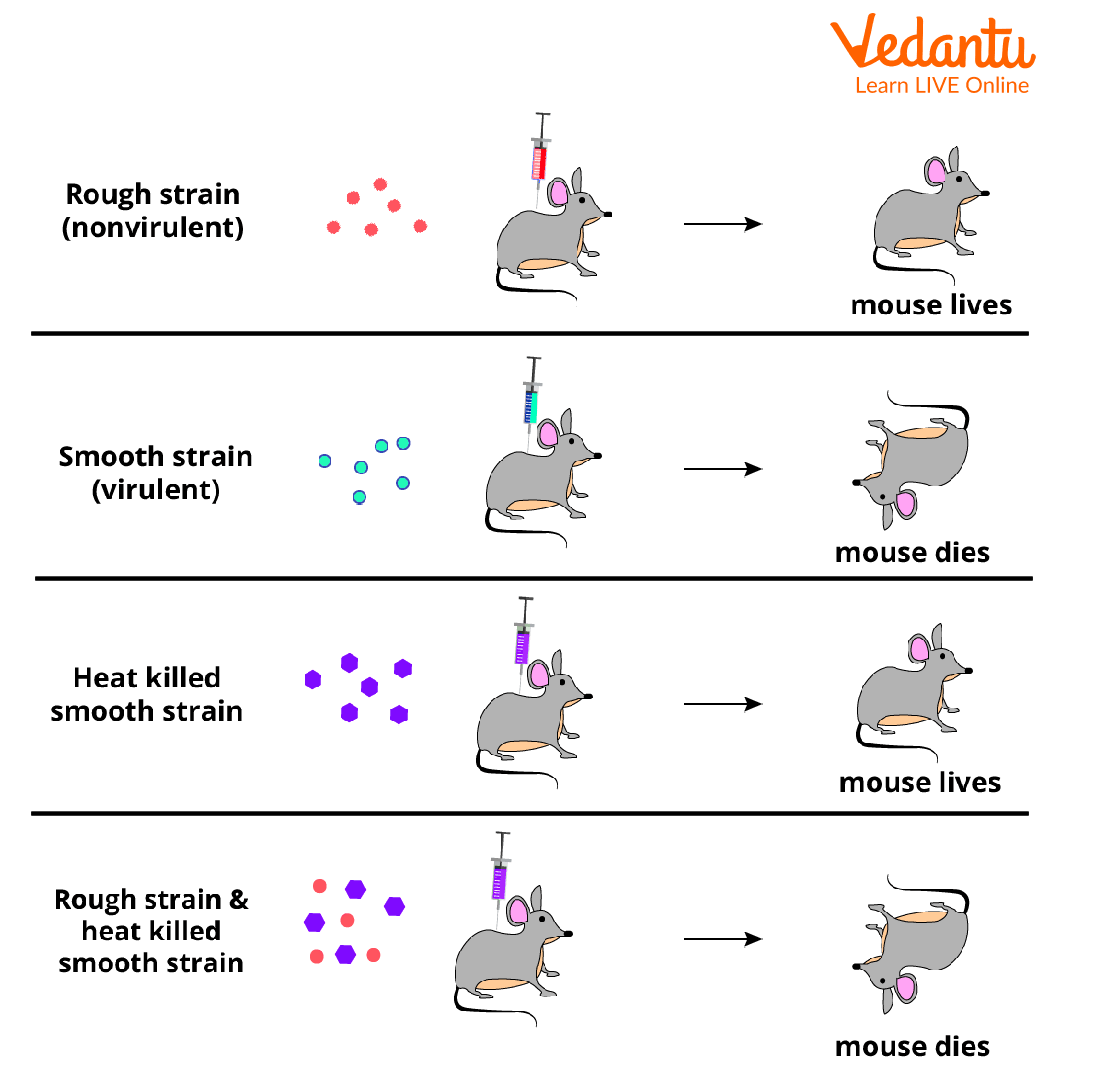Griffith Experiment Steps and Scientific Importance
The Griffith Experiment is a foundational concept in genetics, illustrating how genetic information can be transferred between organisms. It uncovered the process of transformation, which set the stage for understanding DNA as the molecule responsible for heredity.
Frederick Griffith studied Streptococcus pneumoniae, a bacterium that causes pneumonia. He worked with two distinct strains: a smooth (S) strain and a rough (R) strain. The S strain has a polysaccharide capsule, making its surface smooth and enabling it to cause disease. The R strain lacks this capsule, giving it a rough appearance and making it harmless.

R Strain and S Strain of Streptococcus Pneumonia
Griffith’s main goal was to develop a vaccine against pneumonia. During his research, he discovered that harmless bacteria could acquire traits from dead, disease-causing bacteria, making them virulent as well. This was one of the first indications that genetic material could be transferred between living organisms.
Stepwise Breakdown of the Griffith Experiment
-
Injection of R Strain (Rough, Nonvirulent):
Mice survived. The R strain was harmless.
-
Injection of S Strain (Smooth, Virulent):
Mice died. The S strain caused pneumonia due to its protective capsule.
-
Injection of Heat-Killed S Strain:
Mice survived. The heat-killed S strain alone did not cause disease.
-
Injection of Live R Strain + Heat-Killed S Strain:
Mice died. Living S strain bacteria were found in the bodies of the dead mice.

Griffith Experiment Diagram: Steps and Results
In the critical fourth step, harmless R bacteria and heat-killed S bacteria—neither of which could cause disease on their own—were combined and injected into mice. Surprisingly, the mice developed pneumonia and died, and live S bacteria were recovered from their tissues. Griffith concluded that some "transforming principle" from the dead S strain entered the R strain, causing it to transform into a disease-causing form.
Key Terms and Scientific Principles
| Term | Description |
|---|---|
| S Strain (Smooth) | Capsulated, virulent, causes pneumonia |
| R Strain (Rough) | Non-capsulated, nonvirulent, does not cause disease |
| Transforming Principle | Unknown substance (later identified as DNA) responsible for transferring genetic traits |
Scientific Significance
- The experiment demonstrated that nonvirulent bacteria can acquire virulence by absorbing a substance from dead virulent bacteria.
- This process, known as transformation, was foundational for the later discovery that DNA is the carrier of genetic information.
- The Griffith Experiment inspired further research on the chemical nature of genes, leading scientists such as Avery, MacLeod, and McCarty to prove that DNA is the genetic material.
Comparison of Strains and Results
| Step | Bacteria Injected | Effect on Mouse |
|---|---|---|
| 1 | Live R Strain | Mouse lives |
| 2 | Live S Strain | Mouse dies |
| 3 | Heat-killed S Strain | Mouse lives |
| 4 | Live R Strain + Heat-killed S Strain | Mouse dies; live S strain recovered |
Importance of the Griffith Experiment
- Highlighted that hereditary information could be transferred between organisms in a way previously unknown to scientists.
- Laid the groundwork for recognizing DNA as the molecule responsible for heredity, crucial for all living organisms.
- Bacterial transformation, identified by Griffith, is now a key technique in genetic engineering and biotechnology.
Applied Example for Practice
If a mixture of harmless R strain bacteria and heat-killed S strain bacteria is injected into a mouse and the mouse dies, which type of bacteria will be found in its body?
The answer: Live S strain bacteria will be recovered, showing that the R strain transformed.
Next Steps for Mastery
- Review the detailed diagram and stepwise process of the Griffith Experiment.
- Understand differences between transformation, transduction, and conjugation in bacterial genetics.
- For further learning, visit Griffith Experiment: Principle, Steps & Significance and explore related biology concepts.
By understanding the Griffith Experiment, students build a strong foundation for questions and concepts involving genetics, heredity, and the identification of DNA as the universal genetic material. Consistent practice and visualization of these steps make retention easier and exam preparation stronger.


FAQs on Griffith Experiment: Concept, Procedure, and Significance
1. What was the main purpose of Griffith's experiment?
The main purpose of Griffith's experiment (1928) was to investigate how bacteria could transfer genetic information. He aimed to discover the mechanism behind virulence in Streptococcus pneumoniae and found that a 'transforming principle' could convert harmless bacteria into deadly forms.
2. What were the key steps and results of Griffith's experiment?
Griffith performed four crucial injections in mice:
- Step 1: Injected mice with R strain (non-virulent); mice survived.
- Step 2: Injected mice with S strain (virulent); mice died.
- Step 3: Injected mice with heat-killed S strain; mice survived.
- Step 4: Injected mice with a mixture of live R strain + heat-killed S strain; mice died, and live S strain bacteria were recovered from their blood.
3. What was the aim of Griffith's experiment?
The aim of Griffith’s experiment was to understand how bacteria could acquire new traits, specifically how non-virulent bacteria could become virulent, through a mechanism he called transformation.
4. How did Griffith's experiment show transformation?
Griffith's experiment demonstrated transformation by showing that non-virulent R strain bacteria, when mixed with heat-killed S strain, became virulent and could kill mice. This proved that genetic material responsible for virulence was transferred from dead S strain to live R strain cells.
5. What is meant by the 'transforming principle' in Griffith's experiment?
The 'transforming principle' refers to the unknown substance released by heat-killed S strain bacteria that could genetically alter R strain bacteria to become virulent. Later studies proved this principle was DNA, the genetic material.
6. Why did the mixture of live R and heat-killed S bacteria kill mice?
The mixture killed mice because the live R bacteria absorbed genetic material (the transforming principle) from heat-killed S strain, transforming into virulent S bacteria that caused lethal infection.
7. Which scientist(s) identified DNA as the substance responsible for transformation?
Oswald Avery, Colin MacLeod, and Maclyn McCarty identified DNA as the transforming substance in 1944, building on Griffith's experiment.
8. Why is Griffith's experiment important for molecular genetics?
Griffith's experiment is important because it provided the first evidence that genetic information can be transferred between organisms, laying the foundation for the concept that DNA is the hereditary material.
9. What is the difference between R strain and S strain in Griffith's experiment?
The S strain (Smooth) has a polysaccharide capsule, making it virulent and able to cause disease in mice, while the R strain (Rough) lacks this capsule and is non-virulent.
10. What do the terms transformation, transduction, and conjugation mean?
Transformation is the uptake and integration of genetic material from the environment by a cell (as in Griffith's experiment). Transduction is gene transfer mediated by bacteriophages (viruses). Conjugation is the direct transfer of DNA between bacteria via cell-to-cell contact.
11. How did Griffith's experiment influence future research in genetics?
Griffith's experiment led to further studies such as the Avery-MacLeod-McCarty and Hershey-Chase experiments, which conclusively proved that DNA is the genetic material, revolutionizing molecular biology and genetics.
12. What is the significance of the S and R strains in Griffith's experiment?
The S and R strains represent virulent and non-virulent forms of Streptococcus pneumoniae. Their interaction in Griffith's experiment demonstrated genetic transformation and highlighted the molecular basis of heredity.










